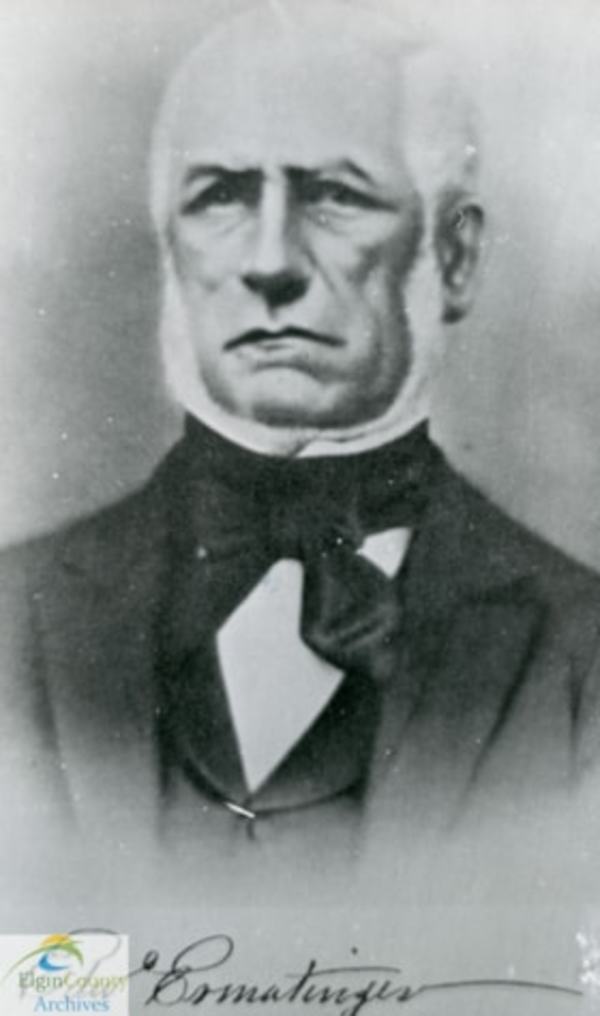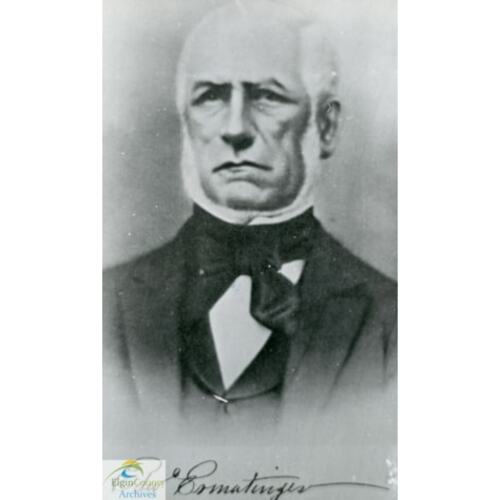As part of the funding agreement between the Dictionary of Canadian Biography and the Canadian Museum of History, we invite readers to take part in a short survey.

Source: Link
ERMATINGER, EDWARD, fur-trader, businessman, politician, and writer; b. in February 1797 on the island of Elba, son of Lawrence Edward Ermatinger, assistant commissary general in the British army, and grandson of Lawrence Ermatinger*, merchant of Swiss origin who married a sister of fur-trader Forrest Oakes*; d. in October 1876 at St Thomas, Ont.
Edward Ermatinger’s mother, an Italian, died when he and his younger brother Francis were infants. Their father – “indeed a good-hearted man – but what a strange Father” – apparently took only a casual interest in their upbringing, but Edward received in England a good education in languages and music. Several members of the family were fur traders – an uncle, Charles Oakes Ermatinger*, established the important trading post at Sault Ste Marie – and Lawrence Edward Ermatinger arranged for his sons’ entry into the service of the Hudson’s Bay Company as apprentice clerks. The brothers sailed from London on Prince of Wales, arriving at York Factory on 14 Aug. 1818.
Edward Ermatinger remained in the company’s service until 1828, at Island Lake, Oxford House, York Factory, Red River (all in present-day Manitoba), and for three years in the Columbia district. His “York Factory express journal,” covering his travels between Fort Vancouver and York Factory, 1827–28, has been published, along with a diary of his canoe journey out to Lachine in 1828. He had, however, little enthusiasm for the life of the trade. “I have long sought to get out of this Country but never could manage it before – now I must struggle once out of it to keep so.” Though there is reason to believe that he was disappointed in his hopes that Governor George Simpson* would promote his advance in the company, he accepted a reverse with equanimity: “I never heartily desired to return.” He was to remain on friendly terms with many former colleagues in the trade, including John Work*, some of whom unburdened themselves freely to this sympathetic correspondent and often asked him for advice on their establishing themselves after retirement. He seems to have had no regrets about leaving the northwest and the “humdrum life we led there.”
Ermatinger visited England in 1828, where he saw his father, but returned to Canada in 1829. He made several journeys through Upper Canada and his diaries suggest that he was seeking a new way of life. He finally settled in St Thomas where he thought he saw opportunities for the profitable employment of his small capital. There, as postmaster from at least 1842 to 1876, banker, and merchant, he remained until his death. He opened a general store, and was successively manager of the Bank of Upper Canada, the Commercial Bank, and for 14 years the Bank of Montreal. When Elgin County was established in 1851 he was the moving spirit in the formation of the Bank of the County of Elgin and was chairman of the board.
Ermatinger contested the Middlesex seat in the Legislative Assembly. In 1844 he was elected as a Conservative. He was defeated in 1847 and by 1851 he had withdrawn from politics: “What I gained in wisdom I lost in pocket.” He did not find congenial a political climate in which “some of the advisers of Her Majesty’s Representatives were the rebels of ’37.” He obviously found more enjoyment in literary composition, writing several pamphlets, many letters to the press, particularly to the Hamilton Spectator under the pseudonym of “British Canadian,” and a biography of Colonel Thomas Talbot*. He also founded the St. Thomas Standard about 1843–44, and edited it for two years before selling it. He married Achsah Burnham, daughter of Zaccheus Burnham* of Cobourg and sister of the Church of England rector at St Thomas. They had seven children.
Edward Ermatinger appears from his correspondence to have been a man of attractive personality, who cherished his friendships. He devoted himself indefatigably to his business, but his diary of a trip to New York records a nightly visit to a theatre or other entertainment. He took great pleasure in music and his proficiency with the flute and violin provided him with enjoyment long after he had left the fur trade. He made a collection of the words and music of French Canadian folksongs, which survives, and one of his friends refers to a “Red River March” he composed. An active man, though introspective, he displayed a lively interest in affairs at home and abroad and held vigorous opinions on the issues he discussed in his letters and published writings. In spite of his freely expressed dislike of the life of the fur trade, he preserved no animus against the HBC and defended it against its critics.
Deeply concerned with religion, Ermatinger was a staunch adherent of the Church of England. He was, as a Mason and an anti-Catholic, no sympathizer with the more conciliatory views espoused by Toronto bishop, John Strachan*, noting that “the vigilance of the laity is required to expurgate the leaven of popery with which [the church] is infected.” He seems early to have won the “estimation of all the most respectable” and to have retained it until his death.
Edward Ermatinger was the author of The Hudson’s Bay territories; a series of letters on this important question (Toronto, 1858), and of Life of Colonel Talbot, and the Talbot settlement, its rise and progress . . . (St Thomas, C.W., 1859). There is also: “Edward Ermatinger’s York Factory express journal, being a record of journeys made between Fort Vancouver and Hudson Bay in the years 1827–1828,” ed. C. O. Ermatinger and James White, RSCT, 3rd ser., VI (1912), sector, 67–132.
PABC, Edward Ermatinger papers, 1828–49. PAC, MG 19, A2 (Ermatinger family papers), ser.2; A21 (Hargrave papers); MG 24, D16 (Buchanan papers); MG 25, G, 107 (Ermatinger family papers). University of Western Ontario Library, 27 (Ermatinger papers), boxes 1–3. HBRS, II (Rich and Fleming); IV (Rich); VI (Rich); XVIII (Rich and Johnson). Vignettes of St. Thomas, an anthology of the life and times of its first century, ed. W. C. Miller (St Thomas, Ont., 1967). C. O. Ermatinger, The Talbot regime; or the first half century of the Talbot settlement (St Thomas, Ont., 1904).
Cite This Article
L. G. Thomas, “ERMATINGER, EDWARD,” in Dictionary of Canadian Biography, vol. 10, University of Toronto/Université Laval, 2003–, accessed March 29, 2025, https://www.biographi.ca/en/bio/ermatinger_edward_10E.html.
The citation above shows the format for footnotes and endnotes according to the Chicago manual of style (16th edition). Information to be used in other citation formats:
| Permalink: | https://www.biographi.ca/en/bio/ermatinger_edward_10E.html |
| Author of Article: | L. G. Thomas |
| Title of Article: | ERMATINGER, EDWARD |
| Publication Name: | Dictionary of Canadian Biography, vol. 10 |
| Publisher: | University of Toronto/Université Laval |
| Year of revision: | 1972 |
| Access Date: | March 29, 2025 |



